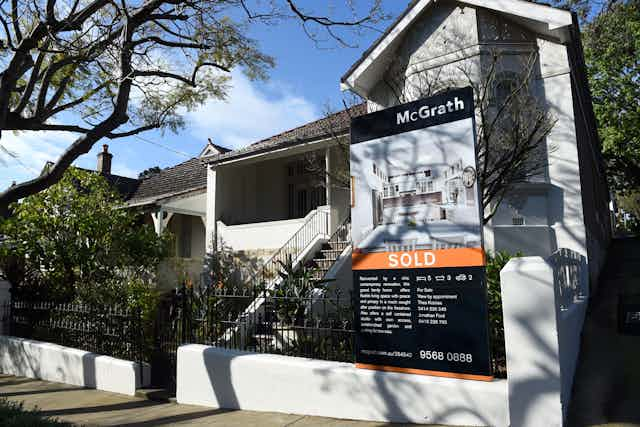The deeper issue behind Australia’s current housing debates is how housing investment will impact on our long-term prosperity.
The International Monetary Fund estimates that Australia’s houses are overvalued by around 10%. The special place of housing arises from a distinctive policy consensus about how the overall economy should be managed and governed, which has dominated major party thinking since the early 1980s, and the institutional priorities this consensus has produced.
The questions we need to ask now are not so much whether house prices will slump, or whether they are too high. Instead, we should ask: what is investment’s role in the wider economy? And how can the underpinning consensus, which is outliving its usefulness, be renewed?
How we got here
This consensus was developed in the early 1980s, originally as a social-democratic project that embraced neoliberal economic reform. It was driven by the need to ensure all citizens benefited from the economy’s modernisation, and for a stable, consensual set of institutional arrangements through which to govern.
As Australia moved from the 1990s into the 2000s, low interest rates and the surge of mining-related income combined with growing private credit to drive house price inflation.
Mining was only one side of a twin boom in which private borrowing for housing purchases has helped drive prices to giddying and unsustainable levels. This is perhaps most obvious outside large cities. Every city in the Anglo world (the US, Canada, the UK, New Zealand, Australia) with a population of fewer than 100,000 people and house prices over five times the median income is in Australia.
Australia emerged from the once-in-a-century resources boom more indebted than when it entered. Bank lending increased between 1985 and 2015 from just above 20% of GDP to almost 130% of GDP. The data reveal that the private debt accumulated by Australians is largely for housing, and largely foreign.
Australia has the world’s highest ratio of housing debt to total lending at 54%. This compares to, for example, 16% in the US, 20% in France, 40% in the UK and 14% in Hong Kong. Australia also has the world’s second-highest ratio of mortgage debt to GDP at 99%.
This places Australia at risk in the event of a downturn in housing prices. But the deeper point is that housing is an unproductive economic investment. Housing is either direct consumption (owner-occupied) or speculative investment (rental returns are below interest rates, implying that buyers rely on future capital gains to make the investment pay).
Even more worrying, Australia’s productive base outside of mining has actually narrowed or declined over this period. Lopsided lending for private housing has diverted finance away from business investment, which should be devoted to the development of new products, services, infrastructure and jobs in non-mining sectors.
Housing finance increased from less than 25% of credit outstanding in 1990 to more than 60% today. Business lending declined from nearly 65% to less than 35% over same period. Finance for new houses declined from 35% of new commitments to 15% today.
This shift also illustrates the Australian economy’s changing structure. Finance and real estate soared from 7% in 1975 of gross value added to 12% in 2015. Mining grew only from 6% to 9%. Manufacturing declined from almost 20% to 7%.
Finance sector profits increased from less than 1% of GDP in 1985 to more than 5% in 2015. The finance sector now makes up almost half (47.5%) of the ASX200’s entire market value.
So, during this period, exports were concentrated into mining while rising wages and currencies hollowed out domestic industry. Private debt rose astronomically to fund house purchases. For two decades, mining investment, rising house prices and escalating government expenditure masked the impact. But as the mining boom subsides, the picture revealed is sobering.
Can we change course?
The current consensus assumes these structural shifts to be rational and inevitable because they are driven by market decision-making.
But as with the previous Australian consensus of the early 20th century, the assumptions and commitments standing behind the consensus are historically contingent. When the facts and circumstances change, the assumptions should be challenged.
Ballooning borrowing to invest in the housing market is impeding investment in the real economy, holding back the development of skills and jobs and driving up inequality. All of these damage Australia’s long-term economic growth.
Australia is not immune to the global forces that have increased returns to capital relative to returns to labour. This shift has left millions of workers facing a decline in real living standards and highlighted their over-dependence on sharemarket and housing price increases for income growth. Yet the 1980s consensus has almost nothing to say about how to respond.
One-and-a-half million Australian households now own more than one residential property. Two-thirds of those under 30 rent their home.
Wealth inequality is as high as it has ever been in Australia. The wealthiest one-fifth of households hold nearly two-thirds of Australia’s net wealth.
Long-run economic development and growth is supported by institutions that distribute opportunity and reward as widely as possible. This makes hard work, creativity and risk-taking worthwhile.
To achieve this in the 21st century, we must renew the consensus through an open, contested debate about Australia’s real and potential sources of comparative advantage and a sustained, long-term effort to invest in those advantages through public policy and private enterprise.
Time for a new consensus: fostering Australia’s comparative advantages, by Jonathan West and Tom Bentley, is published by Griffith Review and available as a free download.

